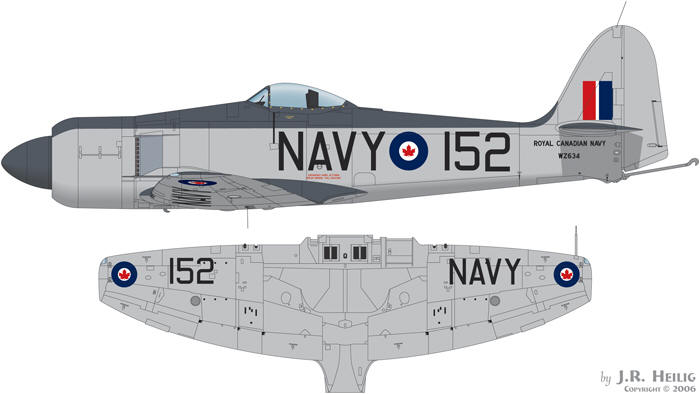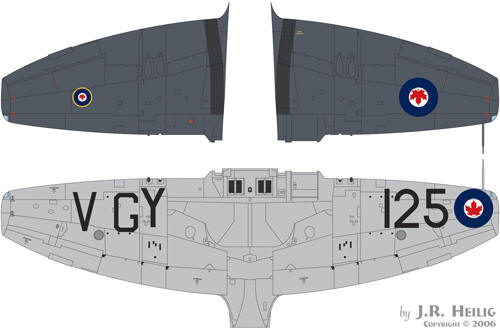The RCN training unit for the Sea Fury was
VT 40. As specified, VT 40 used codes in the 800 series to
denote its training status. This FB.11 (whose serial is,
unfortunately, not known) carried a unique white spinner with a
red star motif during September of 1955. Note the orientation
of the star points to the prop blades. There is speculation
that this might have been the aircraft assigned to the Commander
(Air), HMCS Shearwater. If anyone has information on the serial
number of this aircraft, please contact the author.

When the new RCN marking scheme was
implemented in 1952, aircraft code numbers were supposed to
follow a definite pattern. For operational squadrons, the first
digit denoted the number of crewmembers the aircraft normally
carried, while the second two identified the individual
aircraft. The Sea Fury being a single seat aircraft (the RCN
never operated any two-seat Sea Furies), it naturally received
code numbers in the 100 range - usually. For reasons yet to be
discovered, several aircraft wore codes in the 200 and 300
range. FB.11 TF996/294 of VF 871 circa May 1955 illustrates one
such application, while WZ636/354 illustrates another. The
latter aircraft was delivered from Hawker with this decidedly
non-standard number and number style. Also note the British
style single line service identifier on the aft fuselage. This
seems to be an issue about which Hawker never did get the
message. Also note that WZ636 has smaller than normal maple
leaves in its fuselage roundels.


Hawker seemed to have real trouble with
following RCN markings standards from time to time. The
following illustration shows one of the last Sea Furies
delivered to the RCN, WZ634. While the code number in the 100
block is correct, just about everything else is wrong. It had
squared style codes similar (though not identical) to those seen
on WZ636 above, despite the fact that the RCN specified the
exact same post-war rounded style codes as were in common use by
the RN and RAF at the time. The service identifier was still on
a single line, the "2" in the fuselage code on the left side was
misaligned, the lower wing roundels were 24" in diameter instead
of 36, the lower wing codes were 24" high instead of 36", and
the code and "NAVY" were on the wrong wings! In short, the
airplane was a mess. We can only hope they painted it in the
correct camouflage colors at least.

One last oddity.
An FB.11 coded "125" (whose serial is also unknown) was involved
in a minor mishap aboard the Maggie on 25 May 1953. The
starboard outer wing was damaged, necessitating its replacement
before the aircraft was returned to service. The aircraft was
in standard 1952 markings, but when the replacement outer wing
panel was fitted, it was still
painted and marked in the pre-1952 pattern! Photos
clearly show the 18" diameter yellow-bordered roundel on the
upper surface, and we can assume that the ICAO code "VG" was
probably still present on the lower surface. Since the
aircraft's other markings were standard, this gives us an
aircraft with a lower wing reading "VGY" on one
side (the “Y” being the last letter
in “NAVY” on the fixed inboard wing section) and "125"
plus a roundel on the other!

Home |
What's New |
Features |
Gallery |
Reviews |
Reference |
Forum |
Search